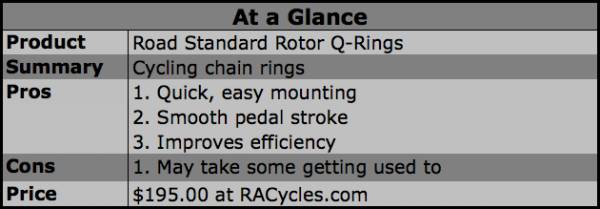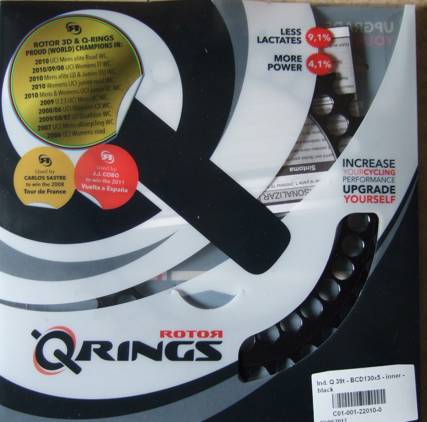
In the last two articles I shared my test of my pedal stroke and my attempts at improving my performance. Although my test was a little limited in time and samples, I learned that with some training I could improve the quality of my pedal pattern. However, this did not appear to better my overall efficiency in being able to produce a certain power output. In this article I continue my quest to make improvements, this time with a mechanical aid in the form of Road Standard Rotor Q-rings.
What are Rotor Q-Rings?

Rotor Q-rings are oval-shaped chain rings that are available in many sizes. The concept is that by using an oval ring, with the major axis or widest part towards the vertical as the pedal reaches the horizontal position, the increase in effective diameter of the chain ring would be similar to engaging a slightly larger gear. This allows the leg to slow down and apply force over a greater proportion of the pedal stroke. When the pedal reaches the top and bottom of the stroke, the effect is equivalent to a smaller gear, and the leg is transitioned more quickly through the region where it is difficult to apply an effective force. There is plenty of information on the Rotor website, along with details of many top athletes using the rings, including claims of “9.1% less lactates and 4.1% more power.”
Buying and Installing My Q-Rings

A brief correspondence with the United Kingdom distributor suggested that, as I was currently using a traditional round 52/39 teeth front chain ring setup, I should start with a 52/39 set of Road Standard Q-rings. This would mean I would not have to make any adjustment to the chain length and only a small change in height to the front derailleur. As the ring rotates, this would be equivalent to alternating between something like 49-56 teeth. The rings were duly ordered and arrived in the post the next day. They were in a flat package, so they slipped through the letterbox easily.
The instructions for the Q-rings are fairly straightforward. The rings have several mounting holes that allow for fine adjustment of the position. These are each marked with small indentations for identification and the suggested starting position is the one with three indents.

Mounting is simple and takes just a few minutes. You loosen the front derailleur, disengage the chain at the front, remove the current chain ring set, and replace it with the Q-rings (note: make sure you order the right type of mounting). It’s a good idea to replace the chain at this time, as using new rings with a worn chain will soon wear out the rings. Readjusting the front derailleur took a little longer to make sure I could shift up and down smoothly, requiring it to be about 5mm higher to accommodate the wider axis.
The instructions for the Q-rings suggest it can take up to 500km of riding to become fully adapted, but I wanted to see if there was any change to my pedal stroke in order to set a baseline for further improvements and compare with my traditional round set. My first impressions were very favorable. The pedal rotation felt smooth and there was no perception of changes of speed or difficulty. I then performed my standard test of riding for five minutes at a constant cadence and power output (200 watts at 90rpm), both with and without the Q-rings and on the same day.
This is the chart of the pedal stroke from the Q-rings:

This is the chart of my pedal stroke on the same day with the normal round rings:

There was not much difference between them. What was noticeable, though, was that my heart rate seemed to have dropped. I performed two tests with each type of ring. Here are my corresponding heart rates:

The circular ring results are similar to my last set of test results, where the peak heart rates were 148bpm. I looked back through an exercise metabolic rate (EMR) test I undertook a few years ago and my current results were consistent with that. From those EMR results to now, my reduction in heart rate of 5bpm is definitely worth several watts.
Although I have not completed the recommended 500km of adaptation, my initial thoughts on the Rotor Q-rings are quite favorable. There is no lumpiness to the pedal stroke and it feels smooth. Fitting was easy and I was a little more efficiency on my two tests. I may need to make a few adjustments as I get used to them, but these Q-rings are definitely staying.
Road Standard Rotor Q-Rings are available for$195.00 at RACycles.com.






